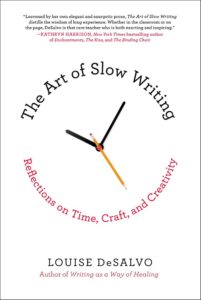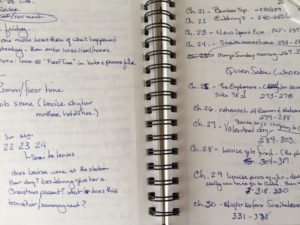I’ve been an advocate for and practitioner of “slow writing” for decades though I never knew there was a name for it. Others can have their NaNoWriMo or their finish-your-novel-in-six-weeks or -a-weekend or however speedily they want to go. A daily practice of anywhere from thirty minutes to two hours with an occasional long weekend or even longer retreat thrown in is what works for me.
 Recently, I began reading The Art of Slow Writing, by Louise DeSalvo, and apparently, I’m not the only slow-writing practitioner. DeSalvo includes stories from some of my hero-writers like John Steinbeck and Henry Miller along with Virginia Woolf and D.H. Lawrence, and a impressive library of other “slow writers,” including DeSalvo herself.
Recently, I began reading The Art of Slow Writing, by Louise DeSalvo, and apparently, I’m not the only slow-writing practitioner. DeSalvo includes stories from some of my hero-writers like John Steinbeck and Henry Miller along with Virginia Woolf and D.H. Lawrence, and a impressive library of other “slow writers,” including DeSalvo herself.
The chapter I read this morning, and what prompted me to write this blog is Chapter 13—Process Journal. This was synchronistic because just yesterday I had gone to the art supply store to buy a new blank book to begin a process journal about my current writing project, which has really taken hold.
The first time I learned about the use of such journals was years ago when I read John Steinbeck’s Journal of a Novel, which he created while writing East of Eden. Each working day, Steinbeck warmed up to the work with a letter to Pascal Covici, his friend and editor at Viking, in which he described his process, his plans, story and character explorations, and more personal notes. (Recommended reading)
 I’ve used process journals for both my fiction and nonfiction writing. In them I copy quotes and excerpts; list books or articles or websites I want to research; plan, organize, and order scenes, chapters, and timelines. I draw maps of settings and jot down character descriptions and lines of dialogue. Weather. Historic events. Plot and chapter ideas. I noodle out notes when I’m stuck and try various approaches to get unstuck. I write outside the story to explore possibilities and backstory and deepen my understanding. I pose story or character or structure problems and sometimes solutions to problems. I write encouraging notes to myself and whiney paragraphs of self-doubt. I start my writing time with the journal and keep it beside my bed at night.
I’ve used process journals for both my fiction and nonfiction writing. In them I copy quotes and excerpts; list books or articles or websites I want to research; plan, organize, and order scenes, chapters, and timelines. I draw maps of settings and jot down character descriptions and lines of dialogue. Weather. Historic events. Plot and chapter ideas. I noodle out notes when I’m stuck and try various approaches to get unstuck. I write outside the story to explore possibilities and backstory and deepen my understanding. I pose story or character or structure problems and sometimes solutions to problems. I write encouraging notes to myself and whiney paragraphs of self-doubt. I start my writing time with the journal and keep it beside my bed at night.
 When I was actively working on my novel, All That Isn’t Singing, I even titled my companion journal “Notes on the Process,” and decorated it with an image of a cover I’d created for the book.
When I was actively working on my novel, All That Isn’t Singing, I even titled my companion journal “Notes on the Process,” and decorated it with an image of a cover I’d created for the book.
In describing Sue Grafton’s process in Chapter 13 of her book, DeSalvo calls it “…a record of the conversation [Grafton] has with herself about the work in progress.” Both DeSalvo and Grafton keep their process journals on the computer. During the writing and pre-writing of Wild Women, Wild Voices, I kept both a hand-written process journal and a sort-of process journal on my computer using Scrivener, which was great for posting images and linking sites as well as outlining and structuring chapters.
The process journal is helpmate, friend, and companion along the way as well as documentation of our process and our work. It’s part of the art of “slow writing.” DeSalvo writes, “Our process journals are where we engage in the nonjudgmental, reflective witnessing of our work. Here, we work at defining ourselves as active, engaged, responsible, patient writers.”
Do you create a process journal for your writing projects?

So glad to have stumbled across your article Judy! It was what I needed to read to put a story I was working on back on the front burner. My Muse & I have taken a detour off the writing road & gotten heavy into drawing/painting to release the creative juices. A drawing a day has kept the words away for over a year but lately little bits of story have been drifting through my heart and your article has let me know all is not lost just slow. Thank You!
Jane Connor
It took me over ten years to finish my first novel. I’d call that very slow. Now that I’m working on my second I continue to take my time but now that I’ve done it before it won’t take me ten years!
Thanks for sharing your experience with your novel, Jill. Nevermind that it took you ten years to finish your first novel, you finished it and to great critical acclaim and the enjoyment of so many readers. Congratulations. We’ll all patiently await your next.
Jill it took me 30 years to work on two novels I eventually tossed except for one. It got deleted but not before the characters and setting asked for a job in the one I did finish — in less than two years.
Judy,
Long time, no reply been away….east coast….I wrote DeSalvo’s book down in order to read it in the near future….
Need to get back to writing and to “myself.”
Arlene
Hey Arlene, how good to hear from you. Hope you had a fine journey to the east coast. Welcome home. All good wishes as you get back to writing and yourself. Bet you find something very interesting there.
Hello Judy,
Very interesting article, I do write process journal when working on patchwork. I do all by hand (piecing and quilting) and I always have a reason to do some specific quilt, so I like to keep a journal about it. I also had a process journal during a novel writing project, but for the moment it’s ‘sleeping’ in my desk.
Have a nice day!
Patricia
Hi Patricia, I really love learning all the ways you work. Now you tell me you do fabric art as well. I guess the process journal can accompany us on any creative journey. Thanks for checking in here.
Thank you for this post. While I often write poems in just two or three drafts (or occasionally one or two), most always the ideas and images have been mulling around in my head for days or weeks. While I have some idiosyncratic ways of structuring my work, I absolutely agree that a writer needs a fertile, private garden of thoughts from which to develop their public bouquets. Oftentimes, finding something in a new work I’m exposed to is like fitting a missing piece in a puzzle; e.g. the madness of the Great Lord in Kurosawa’s “Ran” finally gives me ways to think about running out of vision, running low on apprehension—the Great Lord was arguably still near the height of his powers and prowess, but the abject failure of his vision for his sons (and his kingdom) overwhelmed him beyond what any enemy army ever could. The Great Lord’s lonesome, confused shuffle through his castle, while flaming arrows whiz through windows inches past him, has stuck itself up on the corkboard of my creative mind.
Hi Brian, thanks for posting this. I love all your beautiful imagery in your comments: “fertile, private gardens … to develop public bouquets.” And the image of the corkboard of your creative mind. Wonderful. I have been struck, as I work from 25-year-old memories in my current project, how some of those images from that long ago have found their way into so many other works, a poem here, a story there, some random writing practice piece. Not flaming arrows exactly, but not confused shuffles either.
I read The Art of Slow Writing a few years ago…an amazing book which finally gave a name to my own style. It gave me license to continue writing the way I do…it gave me peace!
Hi Vicki,
Thanks for commenting. I felt much the same way. Though I have lots of writing friends who work the same way I do, it was really great to read the validation of all those writers who are my heroes do it too. Good for us. For all of us Slow Writers.
Your post is timely as I just wrote into my revisions about my dead novel. One of three that took 30 years to write. RIP well maybe just rip. It took me that long to figure out that someone who likes to learn by walking through a thing, cannot write with regimentation.
I never used anything for the novel I actually completed (in less than two years) and I even wrote 85K words. The deceased deleted had half that or less. I refused to hear anything like self doubt or negativism (milestone for me) and just wrote. I did not know what I was going to write, I asked for divine guidance and left it there. The ideas flowed as I sat notebook and computer.
No more novels though. Amen.
Hey Linda,
So I guess 30 years qualifies as “Slow Writing.” ha ha. It’s so good to read about how you “just wrote” and turned the whole thing over and words got on the page. This whole writing thing: such a mysterious, magical journey.